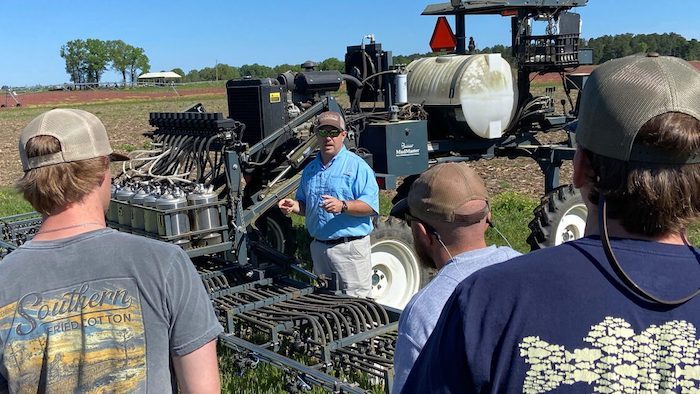Precision agriculture uses cutting-edge technology to make farms more efficient. With experts predicting technology will brighten farming’s future, Clemson University academics, Cooperative Extension Service and research station faculty and staff are joining forces to prepare a skilled workforce for this primary sector of the economy.
The Clemson Precision Agriculture Student Field Day is one example of this collaboration. Held at the Edisto Research and Education Center in Blackville, South Carolina, this year’s field day gave students in the Clemson Agricultural Mechanization and Business Program, as well as students from Piedmont Technical College and Barnwell County Career Center, an opportunity to see technology used in agriculture.
“This field day gives them a chance to see larger equipment, as well as drones, sensors and other types of electronic equipment being used,” Kirk said. “They’ve learned about these things in class, and this field day gives them a chance to see them in action.”
Anna Moore, Andrew Chapman and Carrington Knotts participated in the field day. Moore and Chapman are Clemson students. Knotts is a junior at Strom Thurmond High School and participates in the diversified agriculture program at Piedmont Tech.
Precision Ag as Management Tool
Moore, who is from Evergreen, South Carolina, begins her career in the sawmill industry when she graduates in May. She participated in the field day to see how equipment and technologies she studied in class are used in the field.
“Although the sawmill industry isn’t exactly farming, there are a few things that overlap with precision agriculture,” Moore said. “In both industries, people must obtain accurate and precise data to ensure that they make the best possible management decisions.”
Moore benefited from her participation by getting hands-on experience with various precision agriculture tools and meeting people who are experts in the field.
“One thing that was reinforced during the field day was the importance of proper management in precision agriculture and how creating accurate soil maps is a key part of good management,” she said.
Geographic Information Systems
Chapman, a native of Hartsville, South Carolina, intends to graduate by May 2025. His involvement in the Clemson Ag Mech program has led him to realize his true passion.
“Over the past year and a half, I have found that my true interest is in precision agriculture and geographic information systems,” Chapman said. “I hope to pursue a job that deals with precision agriculture technology after graduation.”
Participating in the field day introduced Chapman to potential avenues for precision agriculture planter attachments and implementing variable rate irrigation.
“Many aspects from the field day were influential to me,” Chapman said. “Looking into the future with precision agriculture, much of the information presented during the field day struggles to make it to rural farms that may truly need it the most. I find that getting this key information to farmers and educating them on certain practices will provide major benefits for growers in the future.”
Chapman plans to work in a precision agriculture-related job after he graduates. He, too, benefitted by attending the field day.
“I am pleased to have been able to meet some of the Clemson Extension researchers and learn about their studies,” he said. “Going forward, when I may have a question, these Extension employees will be there to help when an issue may arise with a crop or piece of machinery.”
Curiosity, Desire Drive Students to Precision Ag
Curiosity and a desire to learn more about research conducted at the Edisto REC are part of the reason Knotts participated in the field day. She plans to be a crop consultant.
“We used to pass by the REC when we were going to the Lowcountry,” Knotts said. “I would see the crops growing in the fields and would talk about how I wanted to work in agriculture. I attended this field day because I wanted to learn more about the research being conducted here and get information related to working in agriculture.”
Technological advancements allow today’s farms and agricultural operations to be more profitable, efficient, safer, and environmentally friendly. As a land-grant university, Clemson is charged with providing agricultural education and information through classes on its main campus, the work of Extension agents and researchers across South Carolina, as well as research conducted at its Research and Education Centers strategically located throughout the state.
The three-sector model in economics divides economies into three sectors: primary, secondary and tertiary. The primary sector includes businesses that produce energy or basic materials, such as coal, oil, metals and crops. Businesses in the secondary sector manufacture goods. The tertiary sector includes businesses that provide services.






